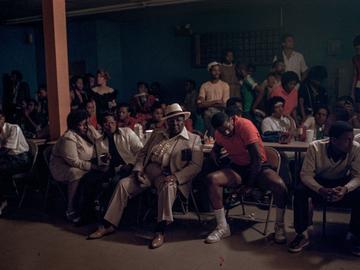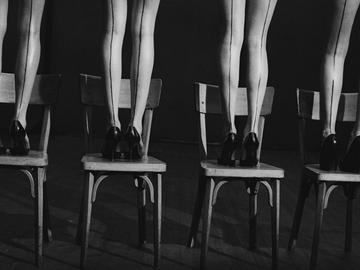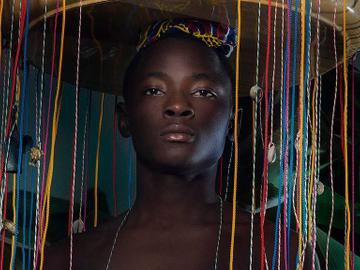After featuring as an emerging talent at Les Rencontres de la Photographie in Arles, the Brussels-based artist Rami Hara now has a solo exhibition at the new gallery in the Marolles district, that's what x said. A chance for him to present his “Hooyo” series, in which he celebrates the beauty of the Muslim veil worn by his mother.
© Rami Hara
The beginning of July 2021 at Les Rencontres de la Photographie in Arles. The prestigious international festival is in full swing. At its fringes, a delegation of eight Belgian photographers take over the streets of the Old Town for two days as part of “Naître aux Mondes”, one of the projects that make up the unmissable “off programme”, focusing on emerging artists. In the shadow of the old city walls, on either side of a discoloured stone staircase, photographs by Rami Hara (27), a Brussels-based artist from Somalia, flutter in the warm wind of the South of France. The images have been skilfully printed on pieces of cloth in a poetic echo of their subject: the Muslim veil and in particular the veil worn by Rami Hara's mother.
As passers-by, festival goers, and other tourists dripping with sweat, climb up and down the steps of the ramparts, Rami Hara strikes up a conversation with curious people who stop in front of his images. “It was quite rough at times,” says Rami Hara. “Some people were not open for a dialogue about the veil and kept holding on to the 'hijab oppresses women narrative'. Granted, in some places in the world they are oppressed. But my work is about Muslim women in the West and how we shouldn't categorise all Muslim women and take away their choices.”
'Hooyo' by Rami Hara
Following its visit to Arles, “Hooyo” is making a stop-over at the gallery that recently opened in the Marolles district, that's what x said. The series, this time printed on paper, consists of portraits of veiled women posing powerfully within a variety of settings, both domestic and urban, as if in a fashion magazine. With one difference: the sumptuous fabrics and the diadems that adorn them are arranged on their heads in such a way as to render their faces invisible. So well that they dominate the images through their presence alone, defying the sacrosanct gaze that is demanded by the rules of portrait photography. “Everyone seems to be obsessed with the hijab. Women who wear the veil are often reduced to their veil, so I wanted to put that into focus,” says Rami Hara.
Although the subjects Rami Hara depicts are veiled from head to toe, they do not resemble one another in any way. The patterns, textures, colours, and ornaments of each cloth, the way the light dances differently on the rippling material, give each veil its own beauty and personality. “When people think of the hijab or the veil, they always picture the black ones, the traditional ones, because that's how the hijab is represented in the media. I wanted to show them they are not all the same. Underneath the burka, each person is a unique individual.”
Muslim women are seen to be responsible for the world we are living in
To create his series of photographs, Rami Hara was inspired by the experiences of several women he knows who wear the veil. But “Hooyo” is above all a tribute to the woman who brought him into the world. “Hooyo means 'mother' in Somali. I wanted to create a work based on the hijab but, as a man, I wasn't sure it was my place. So, I just discussed it with my mom and, hearing about her experiences and how she spoke about how the world is set up, I thought to myself, why not use my mom as my muse?”
The exquisite scarves that bring Rami Hara's images to life belong to her. “I was with my mom when she bought them. It was 2018. We were in Somalia visiting my grandparents just after my master's graduation in visual arts (LUCA School of Arts, ed.) and my mom decided to buy more garments. When I looked at those garments, I saw a personification of all the aspects of her personality: it was colourful and dark at the same time, beautiful and vibrant; I just saw it as the perfect medium to showcase her being.”
A BEAUTIFUL RELIGION
In exploring his mother's veil, Rami Hara does more than just celebrate its beauty; he invites the viewer to see this piece of fabric, which is still profoundly demonised, in a new light. “The hijab is such a symbol of religion; it puts pressure on Muslim women. They are seen as responsible for the world we are living in.” Rami Hara, who has lived in Belgium since he was four years old, has experienced the full force of people's attitudes to Muslim families. “I was always aware that we were seen as different, and it got worse with 9/11. I felt it get consistently worse and worse to the point that Muslim women get attacked, some have even been killed, and it literally happens in public. How can they feel safe in everyday life?”
“My mother does not let the negative outside views of our religion and culture impact her life. Wearing the veil didn't prevent her from being a free woman making her own choices. Islam is a beautiful religion that teaches people to be patient, loving, and caring, but the media only focus on fanaticism and the ugly things that happen,” says Rami Hara. “If you believe in true freedom, you should be able to broaden your mind and see the beauty in other cultures.”
RAMI HARA: HOOYO
28/10 > 28/11, that’s what x said, www.thatswhatxsaid.com
Read more about: Expo , Photography
_Rami_Hara.jpg?style=W3sianBlZyI6eyJxdWFsaXR5Ijo3MH19LHsicmVzaXplIjp7ImZpdCI6Imluc2lkZSIsIndpZHRoIjozNTAsImhlaWdodCI6MjMzLCJ3aXRob3V0RW5sYXJnZW1lbnQiOnRydWV9fV0=&sign=0deef3d950af331a2840992e34af387922f68c6c9f475b9efd7e4609008b28fa)
_Rami_Hara.jpg?style=W3sianBlZyI6eyJxdWFsaXR5Ijo3MH19LHsicmVzaXplIjp7ImZpdCI6Imluc2lkZSIsIndpZHRoIjozNTAsImhlaWdodCI6MjMzLCJ3aXRob3V0RW5sYXJnZW1lbnQiOnRydWV9fV0=&sign=cab3531a17b09abe72906c5e436a7a205f8965b69c140ca155a6d4355e28b4fa)
_Rami_Hara.jpg?style=W3sianBlZyI6eyJxdWFsaXR5Ijo3MH19LHsicmVzaXplIjp7ImZpdCI6Imluc2lkZSIsIndpZHRoIjozNTAsImhlaWdodCI6MjMzLCJ3aXRob3V0RW5sYXJnZW1lbnQiOnRydWV9fV0=&sign=809332d7a807d7a52460076c04736f0f4df0ec2b77b8a1477fcf3370a36a67b0)
_Rami_Hara.jpg?style=W3sianBlZyI6eyJxdWFsaXR5Ijo3MH19LHsicmVzaXplIjp7ImZpdCI6Imluc2lkZSIsIndpZHRoIjozNTAsImhlaWdodCI6MjMzLCJ3aXRob3V0RW5sYXJnZW1lbnQiOnRydWV9fV0=&sign=591994e478019c58f649ca6aec0e92d391137954a3dd01b1c6448fb10ecb34d4)



